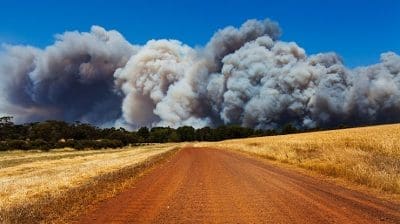Carbon credit specialists say it is inevitable some farm based carbon storage projects will been have impacted by bushfires so far this summer, but it is unlikely proponents will face severe contractual liabilities as a result.
 The Carbon Farming Initiative, part of the Federal Government’s $4.55bn Emissions Reduction Fund (ERF), enables land owners to earn Australian Carbon Credit Units (ACCUs) for activities that help to build carbon stocks in vegetation or in soils.
The Carbon Farming Initiative, part of the Federal Government’s $4.55bn Emissions Reduction Fund (ERF), enables land owners to earn Australian Carbon Credit Units (ACCUs) for activities that help to build carbon stocks in vegetation or in soils.
The ERF enables rural landholders and other land owners and managers to earn alternative sources of income through projects such as tree plantations and soil improvement, but also subjects project contracts to permanence obligations for periods of 25 or 100 years to ensure the benefits are maintained long-term.
If a fire or other disturbance causes a decline in the amount of carbon stored in a contracted project, regrowth must be managed to allow the carbon stock to return to previously reported values, according to Clean Energy Regulator (CER) information.
Alternatively, ACCUs equivalent to the loss of carbon caused by the disturbance can be returned, or relinquished, to the CER.
Last month, as the bushfire crisis worsened, the Clean Energy Regulator issued a statement advising that if at least 50 hectares or 5 percent of carbon project’s total area, whichever is smaller, was affected by fire, proponents must notify the CER in due course.
In a statement provided to Beef Central a CER spokesperson said that as the current fire threat remains active, it was not possible to confirm the impacts of fires on Emissions Reduction Fund (ERF) projects at this time.
“Given the ongoing bush fire threat, the Government is encouraging land holders to prioritise their safety and that of their families.”
However, the CER noted that, thus far, the majority of fire activity had occurred in areas without ERF projects.
As mentioned earlier, all ERF carbon sequestration projects are subject to permanence obligations, which requires the maintenance of carbon stores for which Australian carbon credit units (ACCUs) have been issued.
The CER spokesperson said that if a fire or other disturbance causes a decline in the amount of carbon stored in a project, the project must be managed to allow the carbon stock to return to previously reported values.
In many cases, and depending on climate factors such as rainfall levels, this may involve simply allowing the vegetation to regenerate.
More information on the approach the Clean Energy Regulator will take if properties with ERF projects are adversely affected by bushfires can be found at this weblink.
In one of the first assessments how much land has now been burned, satellite imaging specialists Digital Agriculture Services this week said nearly one million hectares of prime agricultural land has been damaged by bushfires, along with more than 1.6 million hectares of logging forests and tree plantations, and 3.2 million hectares of national parks and other conservation zones.
The spread of ERF projects can be seen on an interactive map on the Clean Energy Regulator website at this link. The site lists 451 projects around Australia that are specific to storing carbon in vegetation, and 65 projects that are specific to agricultural activities.
Matthew Warnken, Director of Corporate Carbon, believed there was little doubt some ERF projects will have been affected by the recent fires, and said the Clean Energy Regulator had been on the front foot in keeping project proponents informed of regulatory requirements.
In terms of impacts on landholders, he said there are force majeure clauses in carbon abatement contracts, and the regulator has flexibility in re-arranging delivery schedules.
“So I would not expect any contractual burden to fall on landholders who are affected by the bushfires,” he said.
“Especially as there is no requirement to ‘hand back’ ACCUs issued to projects that are bushfire affected.
“However they will not receive any additional ACCUs until they recover to the pre-bushfire level of sequestration.
“The overall ERF program has a ‘risk of reversal’ buffer (5 percent of all sequestration from land based projects) to mitigate against these events from an overall program level.
“The areas that are currently bushfire affected do not have large numbers of land based projects with large amounts of abatement – I would say less than 5 percent of projects on an ‘issued ACCU basis’ – so it will not have an immediate impact on supply and demand.”
However he added that it will affect thinking and management around land based projects going forward.

